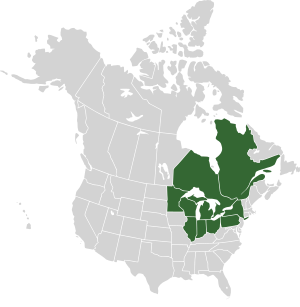| Principles for the Management of Great Lakes Water Resources | |
|---|---|
 | |
| Signed | February 11, 1985 |
| Location | Milwaukee, Wisconsin, US |
| Condition | Signed by 8 Great Lakes governors and 2 premiers |
| Signatories | |
| Languages | |
The Great Lakes Charter is a good-faith agreement among the governors of the U.S. states of Illinois, Indiana, Michigan, Minnesota, New York, Ohio, Pennsylvania and Wisconsin, and the premiers of the Canadian provinces of Ontario and Quebec. The charter outlines a series of principles to collectively manage the use of the Great Lakes Basin's water supply. It also includes a notice and consultation process for proposals to divert large amounts of water out of the Basin and for large in-Basin uses. It was signed on February 11, 1985.[1]
In 2001, the Great Lakes Governors and Premiers signed an Annex to the Great Lakes Charter. This led to the Great Lakes–Saint Lawrence River Basin Sustainable Water Resources Agreement of 2005 and the Great Lakes Compact which became effective in 2008.
The Great Lakes and St. Lawrence Governors and Premiers serves as secretariat to the Governors' and Premiers' Regional Body created by the Agreement and the Governors' Compact Council created by the Compact.
References[edit]
- ^ "The Great Lakes Charter", Council of Great Lakes Governors, Retrieved March 31, 2010.
Well, that’s interesting to know that Psilotum nudum are known as whisk ferns. Psilotum nudum is the commoner species of the two. While the P. flaccidum is a rare species and is found in the tropical islands. Both the species are usually epiphytic in habit and grow upon tree ferns. These species may also be terrestrial and grow in humus or in the crevices of the rocks.
View the detailed Guide of Psilotum nudum: Detailed Study Of Psilotum Nudum (Whisk Fern), Classification, Anatomy, Reproduction